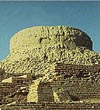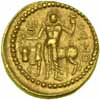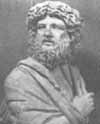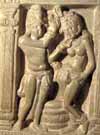|
|
 |
==A
Buddhist stupa at Mohenjo-daro (c.200): In a striking act
of cultural appropriation, a Buddhist stupa is built amidst the ruins
of
Mohenjo-daro [*Routes*],
one of the great cities of the Indus Valley Civilization. |
 |
==Takht-e
Bahi (c.100's-200's): The famous Buddhist monastery at
Takht-e
Bahi, on a hilltop near Peshawar, Pakistan, dates from this period.
A tablet giving most of what little we know about Gondophares was found
here. The monastery probably contains lovely works of art: *Met
Museum*. [*Routes*] |
 |
==Vasudeva
I (c.195-230), the last of the powerful Kushan emperors,
is as thoroughly Indianized as his name. His beautiful coins show Shiva
or Lakshmi, and make heavy use of the Kharoshti script (*grifterrec*).
Vasudeva's capital is at Mathura. [*Routes*] |
 |
=="Apollonius
of Tyana," by Philostratus (c.220) (*livius.org*),
purports to be a biography of the earlier Greek neo-Pythagorean
philosopher.
But in fact the text describes a quite imaginary journey to India, and
mystical conversations with Indian kings and sages (*mountain
man*). |
 |
==Nagarjunakonda
(c.200s) is, besides Amaravati, the other main early Buddhist site in
what
is now Andhra Pradesh. It too is now mostly ruined, with its lovely
pieces
in museum collections. Images: *DSAL*;
*IGNCA*. |






